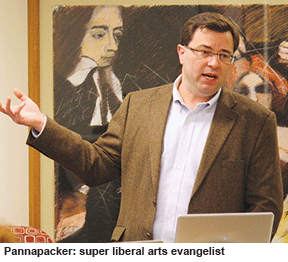THE INDIANA JONES warehouse. That’s where William Pannapacker claims much of the output of students and staff in the liberal arts ends up — in the figurative obscurity represented by the seemingly infinite, but sealed off, government storeroom where the fictional archaeologist’s discovery — the Ark of the Covenant — is placed at the end of Raiders of the Lost Ark.
 Pannapacker is a humanities professor too – in his case, of English literature, at Hope College in Michigan – and he wonders whether in today’s world someone like Jones would ever have found a job outside academia. “We want liberal arts majors to take their educations out into the world, not just end up in graduate school,” with their research unread, he says.
Pannapacker is a humanities professor too – in his case, of English literature, at Hope College in Michigan – and he wonders whether in today’s world someone like Jones would ever have found a job outside academia. “We want liberal arts majors to take their educations out into the world, not just end up in graduate school,” with their research unread, he says.
Pannapacker has become an evangelist for the emerging concept of digital liberal arts, combining collaborative undergraduate research with work experience and digital literacy to create what he calls “the super liberal arts graduate for the 21st century”.
In the US, the idea is spreading fast. Thirteen institutions in the Midwest have just convened a conference aimed at fostering collaboration among their liberal arts departments using digital communication. In addition, Middlebury College in Vermont has hired a post-doctoral fellow in the digital liberal arts, and Whittier College in California and five liberal arts universities in eastern Pennsylvania have also picked up the idea. “We’re trying to create a culture in which we can figure out how to use what’s going on in the digital world to enhance what we do in the liberal arts,” Pannapacker says.
Not coincidentally, digital competency, teamwork and practical experience are precisely what employers have been saying they want — and often fail to get — from graduates. The idea of incorporating them into the curriculum comes at a time when liberal arts institutions in particular are under pressure from business, students and students’ families to demonstrate they are teaching practical skills in exchange for high tuition fees.
“It is, to some extent, about closing the gap between what the job market expects today and what the liberal arts produce,” says Pannapacker. Employers, he adds, “love liberal arts students, but they need somebody to fix their website too”.
Talking about making students more employable, however, creates a difficult balance for backers of the digital liberal arts, since academics bristle at the suggestion. “There are faculty who look at this with a little bit of suspicion, because it’s different from what they’ve done,” says Tim Spears, vice president for academic development at Middlebury.
However, Greg Wegner, director of programme development for the Great Lakes Colleges Association, who ran the Midwest conference, insists that “none of the faculty members who have come to our workshops have done so, because they’re feeling pressure from their institutions to be more practical”. “This is work that’s in support of a liberal arts mission. The gathering of information, the formulation of understanding, and conveying your thinking in a compelling way to a broad audience — these are perfectly in line with a traditional liberal arts tradition,” says Wegner